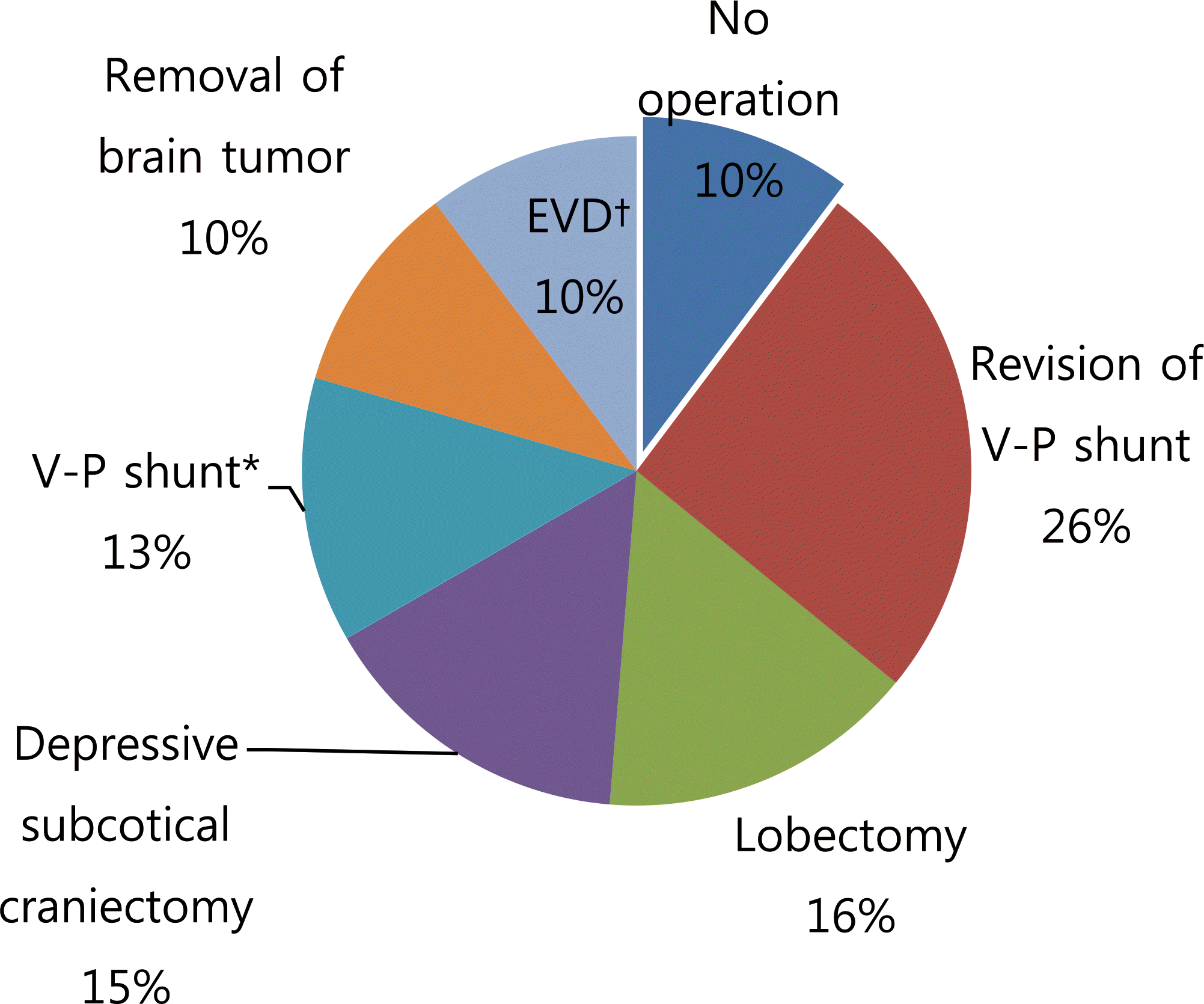Abstract
Purpose
The aim of this study was to investigate the clinical manifestations and laboratory characteristics of eosinophilic meningitis in Severance Children's Hospital. Methods: We examined 6,335 children under the age of 18 years old who had visited the tertiary hospital in Seoul, Korea, and had received cerebrospinal study results between January 2007 and July 2012. The medical records of the patients identified as eosinophilic meningitis were retrospectively reviewed. Results: Eosinophilic meningitis was diagnosed in 39 patients (0.6%). The mean age was 6 years (range 0-18 years) and the sex ratio was 13:1 (22 males and 17 females). The underlying diseases and past history were neurologic disease (n=36, 92%). Eosinophilic meningitis was diagnosed in thirty—five patients who had undergone postoperation neurosurgery (90%). The most common symptoms were fever (50%), headache (20%), vomiting (15%), seizure (10%), and dizziness (5%). The average duration for recovery was five days, and intravenous antibiotics or steroids were used. Conclusions: Manifestations of eosinophilic meningitis are similar to other types of meningitis. The most common cause of eosinophilic meningitis in children was neurosurgery. Eosinophilic meningitis should be considered for patients showing fever and headache after neurosurgery. Through careful investigation, use of improper antibiotics could be avoided.
REFERENCES
1. Kliegman RM. Eosinophilic meningitis ln: Stanton BF, Schor NF, editors. Nelson Textbook of Pediatrics. 19th ed.Philadelphia: Saunders Elsevier;2011. p. 2097–8.
2. LO Re V 3rd, Gluckman SI. Eosinophilic meningitis. Am I med. 2003; 14:217–23.
3. Kessler LA, Cheek WR. Eosinophilia of the cerebrospinal fluid of noninfectious origin: report of 2 cases. Neurology. 1959; 9:371–4.
4. Lo Re V 3rd, Gluckman SI. Eosinophilic meningitis due to Gnathostoma spinigerum. J Infect. 2002; 45:117–20.
5. Noh Y, Hong ST, Yun JY, Park HK, Oh JH, Kim YE, et al. Meningitis by Toxocara canis after ingestion of raw ostrich liver. I Korean Med Sci. 2012; 27:1105–8.

6. Evans RI, McElwain TI. Eosinophilic meningitis in Hodgkin's disease. Br I Clin Pract. 1969; 23:382–4.
7. Weingarten IS, O'Sheal SF, Margolis WS. Eosinophilic meningitis and the hypereosinophilic syndrome. Case report and review of the literature. Am I Med. 1985; 78:674–6.

8. Mulligan MI, Vasu R, Grossi CE, Prasthofer EF, Griffin FM, IL , Kapila A, et al. Neoplastic meningitis With eosinophilic pleocytosis in Hodgkin's disease: a case with cerebellar dysfunction and a review of the literature. Am I Med. 1988; 296:322–6.
9. Quinn JP, Weinstein RA, Caplan LR. Eosinophihic meningitis and ibuprofen therapy. Neurology. 1984; 34:108–9.
10. Rodriguez SC, Olguin AM, Miralles CP, Viladrich PF. Characteristics of meningitis caused by Ibuprofen: report of 2 cases with recurrent episodes and review of the literature. Medicine. 2006; 85:214–20.
11. Bell RS, Vo AH, Cooper PB, Schmitt CL, Rosner MK Eosinophilic meningitis after implantation of a rifampin and mino-cycline-impregnated ventriculostomy catheter in a child. Case report. J Neurosurg. 2006; 104:50–4.
12. Niggemann B, Bauer A, Jendroska K, Wahn U. Latex allergy as a cause of eosinophilia in cerebrospinal fluid in a child with a ventricular shunt. J Allergy Clin Immunol. 1997; 100:849–50.
13. Kennedy CR, Singer HS. Eosinophilia of the cerebrospinal fluid: late reaction to a silastic shunt. Dev Med Child Neurol. 1988; 30:386–90.
14. Jimenez DF, Keating R, Goodrich IT. Silicone allergy in ventriculoperitoneal shunts. Childs Nerv Syst. 1994; 10:59–63.

15. Pittman T, Williams D, Rathore M, Knutsen AP, Mueller KR. The role of ethylene oxide allergy in sterile shunt malfunctions. Br I Neurosurg. 1994. 8z41–5.

16. Fulkerson DH, Boaz IC. Cerebrospinal fluid eosinophilia in children with ventricular shunts. I Neurosurg Pediatr. 2008; 1:288–95.
17. Tubbs RS, Muhleman M, Loukas M, Cohen—Gadol AA. Ventriculoperitoneal shunt malfunction from cerebrospinal fluid eosinophilia in children: case—based update. Childs Nerv Syst. 2012; 28:345–8.
18. Woods CR, Englund I. Congenital toxoplasmosis presenting with eosinophilic meningitis. Pediatr Infect Dis I. 1993; 12:347–8.

19. Miron D, Smelling LK, Josephson SL, Skurkovich B. Eosinophilic meningitis in a newborn with group B streptococcal infection. Pediatr Infect Dis I. 1993; 12:966–7.

20. Williams IH, Koster LS, Naidoo V, Odendaal L, Van Veen-huysen A, de Wit M, et al. Review of idiopathic eosinophilic meningitis in dogs and cats, with a detailed description of two recent cases in dogs. I S Afr Vet Assoc. 2008; 79:194–204.
Fig. 1.
Surgical distribution of 39 patients with eosinophilic meningitis. ∗V-P shunt, Ventriculoperitoneal Shunt; EVD, External ventricular drainage.

Table 1.
Clinical Presentation of 39 Patients with Eosinophilic Meningitis
| Clinical symptom and sign | No. of patients (%) |
|---|---|
| Fever | 19 (50) |
| Headche | 9 (20) |
| Vomiting | 6(15) |
| Soft tissue inflammation (op site swelling) | 5(12) |
| Seizure | 4(10) |
| Dizziness | 2 (5) |
Table 2.
Clinical Characteristics of 39 Patients of Eosinophilic meningitis
| Characteristics or median [range] | No. of patients (%) |
|---|---|
| Demographics (N=39) | |
| Aqe (yr) | 6 |
| Sex (M/F) | 22/17 |
| Underlying disease and Past history | |
| N (overall %) | |
| Neurologic disease | 36 (92) |
| N (within group %) | |
| Brain hemorrhage | 10 (28) |
| Brain tumor | 8(22) |
| ArnoId-Chiari svndrome | 8(22) |
| Epilepsy | 2 |
| Tethered cord syndrome | 2 |
| Lennox-Gastaut syndrome | 1 |
| Focal cortical dysplasia | 1 |
| Cavernous malformation | 1 |
| Arachnoid cyst | 1 |
| Tuberous sclerosis | 1 |
| Acute disseminated encephalomyelitis | 1 |
| Arum: infectious disease | 3 (8) |
| Drum history∗ | 23 (60) |
| Operation t | 35 (90) |
| Treatment | |
| Use of antibiotics | 31 (79) |
| Use of steroid | 8(20) |
| Duration of Sx (days) | 5[1-15] |




 PDF
PDF ePub
ePub Citation
Citation Print
Print


 XML Download
XML Download